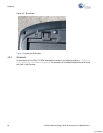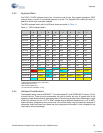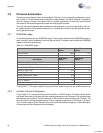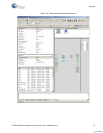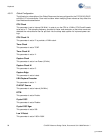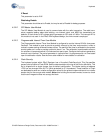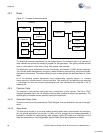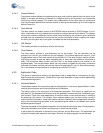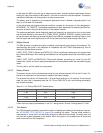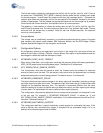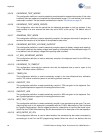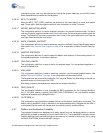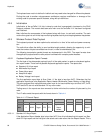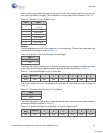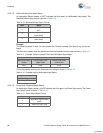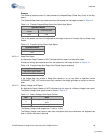
62 CY4672 Reference Design Guide, Document # 001-16968 Revision **
Keyboard
In idle state the MCU and radio go to sleep to save power, and the keyboard application remains
waiting for input from the keys or Bind button. The timer is turned off to conserve power. This state is
maintained indefinitely until a keystroke or a button press occurs.
The battery level is reported by the keyboard application when it detects a keystroke after it has
been in an idle state for 8 seconds.
In the active state the keyboard attempts to deliver a packet for the amount of time designated in
KEYBOARD_TX_TIMEOUT. The keyboard application is also responsible for detecting the Bind but-
ton press and then calling the bind function in the protocol module.
The keyboard application sends keyboard reports as frequently as events arrive, but not any faster
than the time defined in the macro KEY_DOWN_DELAY_SAMPLE_PERIOD. Carefully set this time
so that the report rate does not exceed that which the USB bus is capable of handling. Keep in mind
that the report rate varies slightly due to drift of the internal oscillator used to keep track of time.
4.3.5.2 Mfgtest Module
The RDK provides a compile-time option of adding a manufacturing test mode to the keyboard. The
manufacturing test code in this keyboard is compatible with the CY3631 Manufacturing Test Kit
offered by Cypress Semiconductor.
If MFG_TEST_CODE is defined and ENTER_BY_PIN is not defined, holding down the system sleep
key and the Bind button while inserting the batteries into the keyboard enters the manufacturing test
mode.
If MFG_TEST_CODE and ENTER_BY_PIN are both defined, connecting pin 4 and 5 on the ISP
header with a shunt and then inserting the batteries into the keyboard enters the manufacturing test
mode.
The only way to exit this mode is to cycle power.
4.3.5.3 Battery Module
The battery monitor circuit is implemented using the Low Voltage Interrupt (LVI) on the LP radio. Fol-
lowing is an explanation of the process to measure the battery voltage.
The process first sets the LVI threshold to 1.8V and then checks for an LVI interrupt. If the interrupt
does not occur then it repeatedly sets the LVI TH and PMU OUTV with the following combination
and checks the status.
It then returns a battery level between 1 and 10: 1 being below 1.8V and 10 being above 2.7 volts.
4.3.5.4 Test Module
This RDK keyboard provides a compile-time option of adding test modes to the keyboard; see sec-
tion KEYBOARD_TEST_MODES on page 64 for enabling this option. The test mode module is
implemented in a way that it can be easily extended to add other test modes. Currently there are
only two test modes supported in the module. When this option is not enabled then all test mode
code is removed from the compilation.
Table 4-3. LVI TH and PMU OUTV Combinations
LVI TH PMU OUTV VOLTAGE IF INTERRUPT OCCURS
1.8V 2.7V < 1.8V
2.0V 2.7V < 2.0V
2.2V 2.7V < 2.2V
PMU OUTV 2.7V < 2.7V
[+] Feedback



